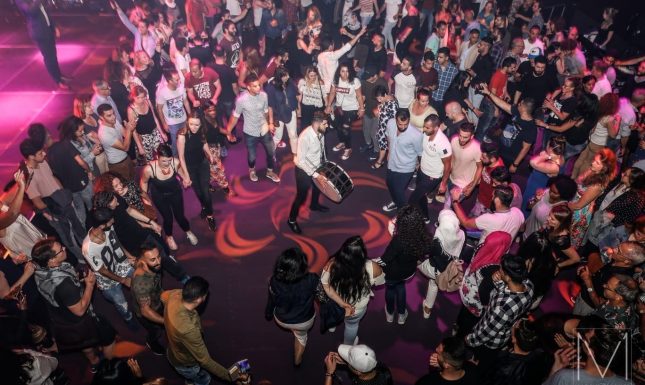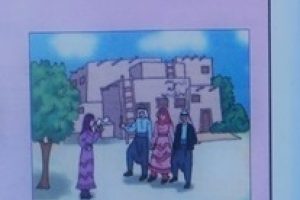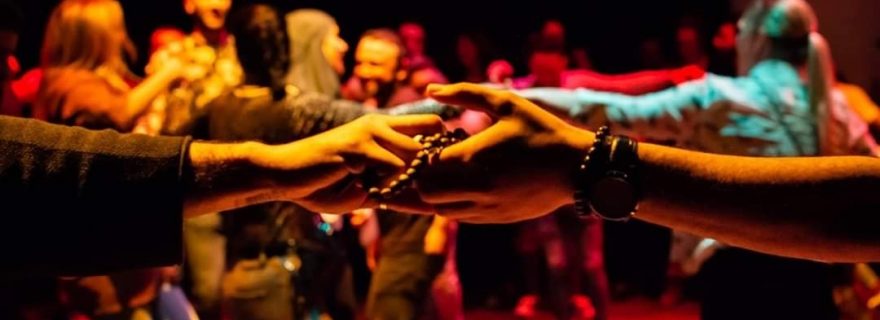Dabke on Dutch Dancefloors: Reattribution of Folk Tradition
Dabke is often framed as a village dance. The current popularity of dabke performances in the Netherlands shows how migration attributes new meaning to traditional practice. Diasporic dabke swings between reinvention of identity and creative cultural exchange.
The recent arrival of a significant number of Syrian refugees to the Netherlands not only caused public concern and a largely negative media coverage, it also resulted in quite a number of civil society initiatives that aim to facilitate contact between newcomers and locals. In addition, it introduced the Dutch public to lesser known yet very enjoyable aspects of Syrian culture, one of them being dabke (Ar: dabka / دبكة), often described as a traditional Arab, Levantine, or Middle Eastern folk dance. Similar to Greek and other south-eastern European folk dances, it is a (circular) line dance that is characterised by holding hands and stamping on the ground. The verb ‘to dabke’ means to stamp on the ground, according to its earliest known reference in Arabic:
ادبك يدبك دبكا ودبّك تدبيكاً قرع الأرض برجله أو بغيره
“One who dabkes stamps on the ground in the particular manner of dabke, and he renders dabke by stamping the ground [of the village] with his foot, or by other means.” Boutros al-Bustani (1869), Muḥit al-Muḥit , p. 624.
Because of its catchy rhythm and energetic appeal, it has become increasingly popular in the Netherlands. Dabke workshops and dabke nights are organised all over the country. And if there is no scheduled dabke, there is spontaneous dabke. One aspect that stands out – apart from the fiery enthusiasm of the dancing crowd – is Syrians who picked up on dabke only after their arrival to the Netherlands. This, however, does not imply that they resemble Dutch people who join in for the first time. It is just that dabke was not really part of their regular night out before.

As with other folk dances, dabke is often associated with rural regions and village life. In urban settings, it is usually only danced on wedding occasions or as ‘street-level defiance’ during anti-government protests (in Syria as well as Lebanon).
Inspired by 19th century Romanticism which celebrates ‘traditional’ cultures and ‘uncomplicated’ social structures, colonial powers, subsequent Arab regimes, and Middle Eastern intellectual elites constructed a romantic image of the countryside as honourable, rustic, serene, and slow-paced. Moreover, as a steadfast constant in an ever-changing world, the village became an emblem of national identity.
In line with the global rise of nationalism, 20th century Middle Eastern nationalists looked for ‘authentic’ cultural practices that could be used to construct a distinctive (pan-)Arab, Syrian, or Lebanese identity. Before the 1950s there was no such thing as Syrian dabke or Lebanese dabke. Both in Syria and Lebanon, efforts were made to canonise dabke styles from different regions. This standardisation led to the emergence of nationalised dabke styles that embody national identity. As an identity marker, dabke is employed to reinforce collective identity, solidarity, and a sense of belonging. Likewise, it is attributed with egalitarian qualities, for it suspends social hierarchies and differences in ethnicity, religion, and gender. Dabke is thus a dance of and by the people. In this sense, it is a ‘popular’ and ‘folk’ tradition. It also has a strong rural connotation and is often described as a ‘village dance’.
Just like elsewhere in the world, increased urbanisation and industrialisation paved the way for a nostalgic idealisation of rural regions and village life. This rural idyll differentiates between an industrialised urban present and a romanticised rural past, and is often accompanied by a longing for the latter. The village thus represents a time when and place where life is simple and stable. In this framework, dabke performances signify ‘unchanging village life’ as described by Shayna Silverstein in her dissertation Mobilizing Bodies in Syria: Dabke, Popular Culture, and the Politics of Belonging.

Of course, everything changes over time and so, different migration waves have brought this Middle Eastern village dance to the big city and beyond. Here in the Netherlands, dabke is performed as a means to revive – it sure is lively! – and revoke a home left behind. This way, traditional practice is transported to a new sociocultural context and attributed with new meaning. Far away from the Syrian village square or wedding hall, dabke is reinvented both as a nostalgic evocation of a lost home and as celebratory intercultural cement used to build a new one.
For an overview of dabke related events and information on upcoming dabke parties, please visit the Dreaming of Syria Foundation Facebook page or the Dabke Night website.
During the Middle Eastern Culture Market 2019 on 30 November & 1 December, visitors can participate in a dabke workshop.



0 Comments